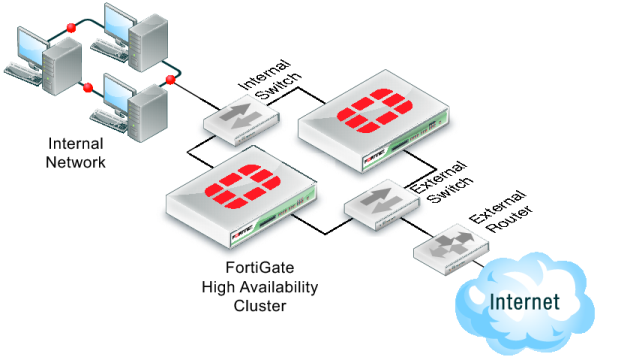About the FGCP
FortiGate HA is implemented by configuring two or more FortiGate units to operate as an HA cluster. To the network, the HA cluster appears to function as a single FortiGate unit, processing network traffic and providing normal security services such as firewalling, security services, Unified Threat Management (UTM) and VPN services.
Inside the cluster the individual FortiGate units are called cluster units. These cluster units share state and configuration information. If one cluster unit fails, the other units in the cluster automatically replace that unit, taking over the work that the failed unit was doing. After the failure, the cluster continues to process network traffic and provide normal FortiGate services with virtually no interruption.
Every FortiGate cluster contains one primary unit (also called the master unit) and one or more subordinate units (also called slave or backup units). The primary unit controls how the cluster operates. The role that the subordinate units play depends on the mode in which the cluster operates: (Active-Passive (AP) or Active-Active (AA) (see
“Active-passive HA (failover protection)” and
“Active-active HA (load balancing and failover protection)”).
The ability of an HA cluster to continue providing firewall services after a failure is called failover. FGCP failover means that your network does not have to rely on one FortiGate unit to continue functioning. You can install additional units and form an HA cluster.
A second HA feature, called load balancing, can be used to increase performance. A cluster of FortiGate units can increase overall network performance by sharing the load of processing network traffic and providing security services. The cluster appears to your network to be a single device, adding increased performance without changing your network configuration.
Virtual clustering extends HA features to provide failover protection and load balancing for Virtual Domains (VDOMs). See
“Virtual clusters”.
FortiGate models that support redundant interfaces can be configured to support full mesh HA. Full mesh HA is a method of reducing the number of single points of failure on a network that includes an HA cluster. For details about full mesh HA, see
“Full mesh HA”.


